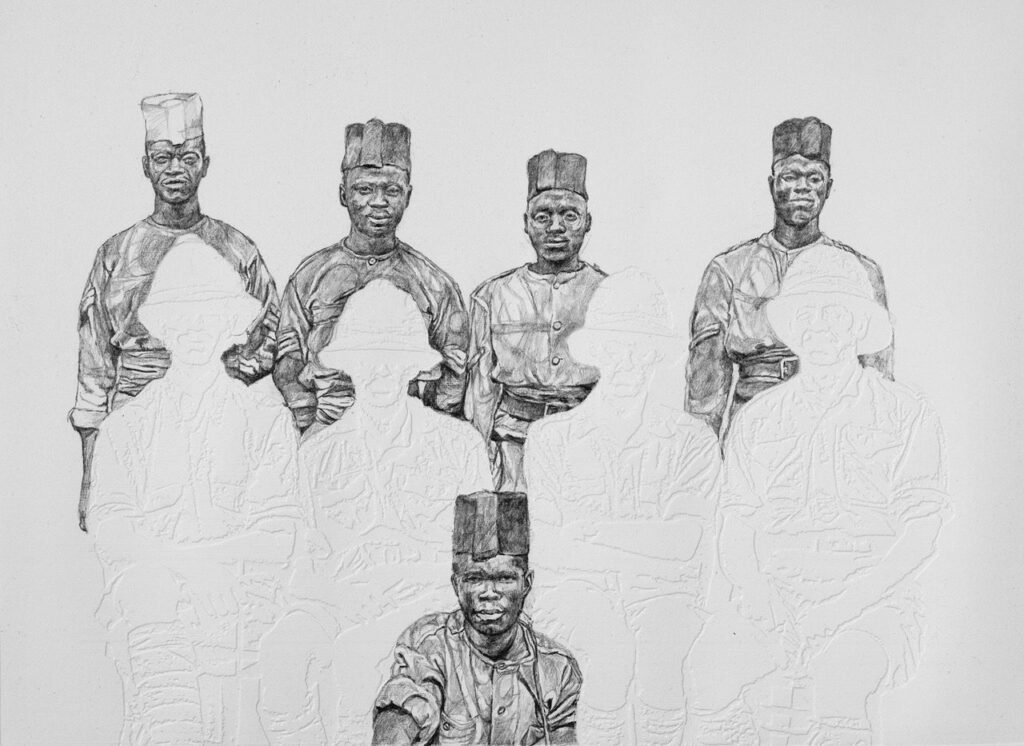Kristin Hjellegjerde, Londres, United Kingdom
08 Jan 2017 - 18 Feb 2017

Barbara Walker 'Exotic detail in the margin' 2016, (graphite on embossed paper, 52 x 40cm | 20 1/2 x 15 3/4in)
“Why you? Why us for that matter? Why anything? Because this moment simply is. Have you ever seen bugs trapped in amber?… Well, here we are, Mr. Pilgrim, trapped in the amber of this moment. There is no why.”
-Kurt Vonnegut, Slaughterhouse-Five
A group show featuring drawing-based works, Everything Exists Now (8th January – 18th February 2017) at Kristin Hjellegjerde gallery, brings together 13 artists who each reflect on their current moment through personal, political and historical viewpoints, united by the common lens of time. Hailing from different backgrounds and artistic practices, the final whole is a nod to the concept of Eternalism, a space in which each moment exists in and of itself, an endless loop in which all these points exist at once. If, indeed, the idea really is that Everything Exists Now, then all moments are present simultaneously.
The artists are linked to each other by disparate yet complementary threads. Historicity, for example, finds life in the Research Lectures series of Chinese artist Zhu Wei, who critiques the darker side of a rapidly evolving China. Birmingham-based artist Barbara Walker’s ongoing Shock and Awe drawings bring to the fore the under-recognised role of black servicemen and women in the British Armed Forces and war efforts from 1914 to present day. The fractured politics of the present are parsed through British Chris Agnew’s new mixed media series, Hypnic Jerks, in which the physical phenomenon acts as a metaphor through which various socio-political events are examined, both personal and public. Also commenting on the present is Korean Sook Jin Jo’s powerful Je Suis series. Combining photography with ink, charcoal and gouache, they reference the recent violence in France, and stand as a symbol of strength, protection and freedom. Her work often has an environmental slant as well, something Celina Teague’s coloured pencil works also touch upon, with their preoccupation with the relentless and senseless slaughter of elephants and rhinos.
Fragmentation, meanwhile, emerges in the work of Paris-based Moroccan artist Mohamed Lekleti. His Plastic Anagrams feature broken up hybrids; men, women, and body parts in montages uniting ecstasy and violence, as if viewing multiple timeframes at once. This sensation of disintegration finds a common ground in Saad Qureshi’s delicate plywood pieces. Much of his work looks to capture memories, examining how they are subject to constant revision, a chain of disconnected details that make up a past that is under constant scrutiny. The past is also found in Ali Kazim’s Ruins. These watercolour drawings illustrate the landscape outside of Lahore, once the flourishing Indus Valley, and now a desolate landscape that serves as a burial site, still dotted with ancient mounts and strewn with terracotta shards from a distant past. Two London-based artists deal with the cutting up and slowing of time: Marie Harnett takes moments from films, a fragment of time, to capture a split second film still, laboriously reproducing it in pencil, as in Karenina, making a moment exist forever. Caroline Jane Harris, meanwhile, has captured the fleeting composition of one of her pixelated hand-cut photographs. Slow Data (Window), is a drawing physically executed in layers akin to a 3D printer; the process reveals an image passing through the realms of the three-dimensional to the digital, alluding to the irreversible direction of time and technological obsolescence in our fast-paced age.
Indeed, time moves, and it moves relentlessly. If Zhu Wei examines the effects of social change in China, then Ethiopian Dawit Abebe’s Mutual Identity mixed media works examine the impact of technology on individuals in his home country, but also the effect on social interaction as a whole. Norwegian artist Kristin Evju also meditates on change, creating a semi-fictional historical narrative in Punchcard, a series of drawings examining a near-distant past in which tech that was once so groundbreaking is already a place we cease to understand. Elsewhere, as in Sverre Malling’s latest drawings, fragments are drawn together from many sources: futuristic images converge with those from the past in a contradictory fashion. He seeks to translate into drawing using the collage form as a cognitive form of expression. These fragmented images exist in a state of flux, floating between concept, form and expression.
All histories, all thoughts, all memories, fragmented as they are over the sands of time, hover in the same moment; our pasts and presents and futures all hover in one, overarching ‘now’, and all we can do is seek to let go and float within it. Or, in the words of Kurt Vonnegut: “I asked myself about the present: how wide it was, how deep it was, how much was mine to keep.”
Participating artists: Dawit Abebe, Chris Agnew, Kristian Evju, Marie Harnett, Caroline Jane Harris, Sook Jin Jo, Ali Kazim, Mohamed Lekleti, Sverre Malling, Celina Teague, Saad Qureshi, Barbara Walker and Zhu Wei.
.
ARTIST TALK Hosted by Daniel Barnes
Sunday the 12th of February, 4PM
.
http://kristinhjellegjerde.com